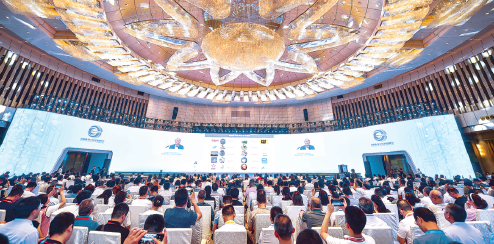Potential of Shanxi's digital future in focus
Updated: 2023-09-01

Delegates at the fourth Jinyang Lake Digital Economy Development Summit, which opened on Aug 23. [Photo by Shi Xiaobo for China Daily]
About 1,000 people from ministries, universities and enterprises meet in Taiyuan to discuss province's impressive achievements and plans
Experts and industry insiders from the digital sector throughout the country gathered at a summit in Shanxi last week, sharing insights into promoting digital-empowered transformation in the province.
The three-day event – the fourth Jinyang Lake Digital Economy Development Summit – opened in Taiyuan, Shanxi province, on Aug 23.
Some 1,000 participants, including representatives from national ministries and provincial government departments, industry associations, universities, research institutes and enterprises, attended.
The event, evolving from the Jinyang Lake Summit on the Integrated Circuits and Software Industries in 2020, is now one of the highest-level industrial events in Shanxi.
The theme of this year's summit was "empowering transformation with digitalization, creating a smart and better life together".
Liu Yong, deputy chief of the Shanxi Department of Industry and Information Technology, said the summit aims to build a national exchange platform for digital economic development and accelerate the comprehensive development of the digital economy in Shanxi.
The summit took place online and offline at the Jinyang Lake International Conference Center with activities such as the opening ceremony, a keynote forum, 16 subforums, a digital economy exhibition and related industry events.
The digital economy exhibition was an important part of the event. It exhibited the core sectors of the digital economy; digitalization for characteristic towns with specialty industries; the integration of the coal industry and digital technology; industrial internet applications and the supply of basic information technology services.
During the event, the operation of several key research facilities and industrial establishments were announced. These included an open innovation platform for data processing, computing and algorithm for the artificial intelligence industry; the first provincial center for the promotion of digital-empowered transformation; the Shanxi Comprehensive Service Platform for the Industrial Internet; and several demonstration zones for the digital economy.
Many attendees praised the stronger influence of the event. Zhou Yue, general manager of Yundee Intelligent Science and Technology, is a frequent participant in the event. He said this year's summit was larger in scale compared with previous sessions and was more professional and focused on market segmentations.
"More new delegates are coming to this year's summit, showing its increasing recognition," Zhou said.
He added that he is also impressed by the latest development in digitalization in Shanxi.
"Digitalization is playing a growing role in upgrading Shanxi's traditional industries, especially the energy sector, and the results are encouraging," Zhou said.
Many experts and industry insiders noted that Shanxi has been implementing an energy revolution campaign. It aims to upgrade the traditional coal industry toward the direction of cleaner, more efficient, smarter and safer operations, and accelerate the development of new options like hydrogen, coal-bed methane, solar and wind power.
They agreed that digitalization is a feasible approach to achieving the targets of energy revolution.
Sun Hongbin, vice-president of the Taiyuan University of Technology, advocated the establishment of "the internet of energy" for sharing technologies, information and other resources among the various sectors and stakeholders of the industry.
Liu Feng, vice-chairman of the China National Coal Association, highlighted the role of digitalization in developing intelligent coal mining operations.
"Carbon peak and neutrality are now the new requirements for China's sustainable development," Sun said. "But when it comes to the coal industry, it's not simply a practice to reduce output."
He added that this is true especially in Shanxi, which is shouldering the mission to ensure coal supply throughout the country and safeguarding national energy security.
"Shanxi's practice shows that emissions reduction can be made possible through digitalizing coal mines, power plants and other coal-related facilities, without sacrificing output and supplying capacity," Sun said.
Latest statistics show that Shanxi has developed 48 intelligent coal mines and 1,217 intelligent mining shafts.
As a result of industrial upgrades driven by digital, intelligent and environmentally friendly technologies, about 80 percent of Shanxi's coal output in 2022 – which stood at 1.3 billion metric tons – was produced by advanced facilities with cleaner, safer and more efficient operations.
Many delegates to the summit also suggested Shanxi improve its "computing power" and digital infrastructure to drive digitalization across all socioeconomic fronts.
According to industry insiders, computing power is the processing power of a computer or computing centers. Computing power is associated with data and algorithms. The three constitute the basic elements that promote the development of AI and other digital technologies and applications.
Liu Qingliang, a representative from Huawei Technologies, said that "the development of AI and other digital applications requires large computing power, which is backed by a strong cluster of digital infrastructure like high-speed computers, data storage and processing facilities, and a powerful telecommunication network".
Chen Shiyi, a member of the Chinese Academy of Sciences, said that computing power is playing an increasingly important role in industrial modernization.
He explained that the new round of industrial modernization is empowered by digitalization featuring the combination of computing power, AI and big data.
Experts also praised Shanxi for its development of computing power-related infrastructure.
Latest statistics show that Shanxi is now among the top 10 nationwide in terms of computing power, with more than 827,800 computers in its various data centers.
Currently, the province has built more than 85,000 5G base stations, fulfilling its five-year target three years in advance.
Yao Yi contributed to this story.



